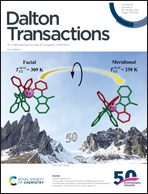Fast transport of HCl across a hydrophobic layer over macroscopic distances by using a Pt(ii) compound as the transporter: micro- and nanometric aggregates as effective transporters†
Abstract
Bis-(diethyl-dithioxamidate)platinum(II) is able to transport HCl from the donor aqueous phase to the receiving one over a mean distance of 12 cm in about 3 minutes across an organic membrane in the bulk, without stirring of the organic phase, i.e. at a rate far exceeding the unidirectional macroscopic diffusion coefficient. The way in which this surprising phenomenon can happen is linked to the behaviour of HCl which, because of dynamic interactions with [Pt(HEt2C2N2S2)2] (in which HCl is hosted as a tight ion pair [Pt(H2Et2C2N2S2)2][Cl]2) and chloroform molecules, gives rise to observable nanometric and micrometric domains, more dense than the surrounding bulk, whose formation and disaggregation processes accelerate the unidirectional macroscopic diffusion of HCl. Thermodynamic parameters obtained from the study of acid–base behaviour of the system Pt(II) species/HCl/CHCl3 also agree with the proposed mechanism of HCl transport.



 Please wait while we load your content...
Please wait while we load your content...